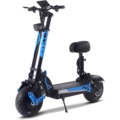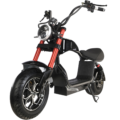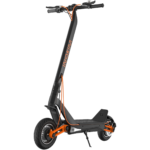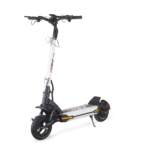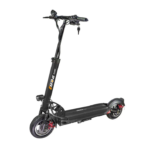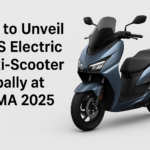- Home
- Scooters
- Electric Scooters
- MotoTec Cruiser
MotoTec Cruiser


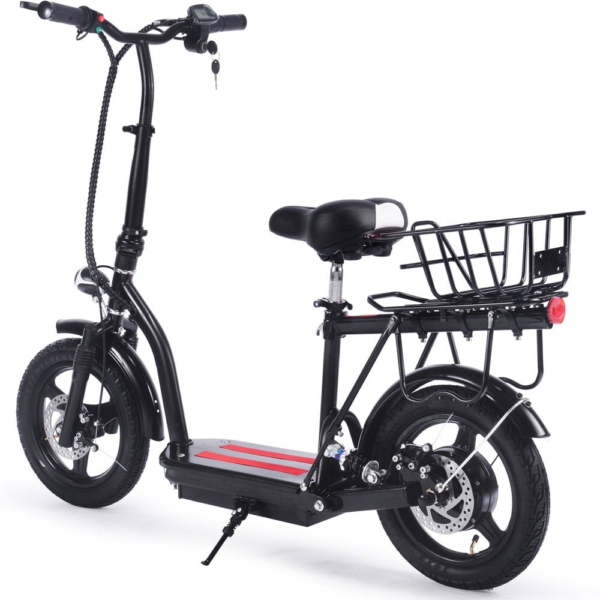
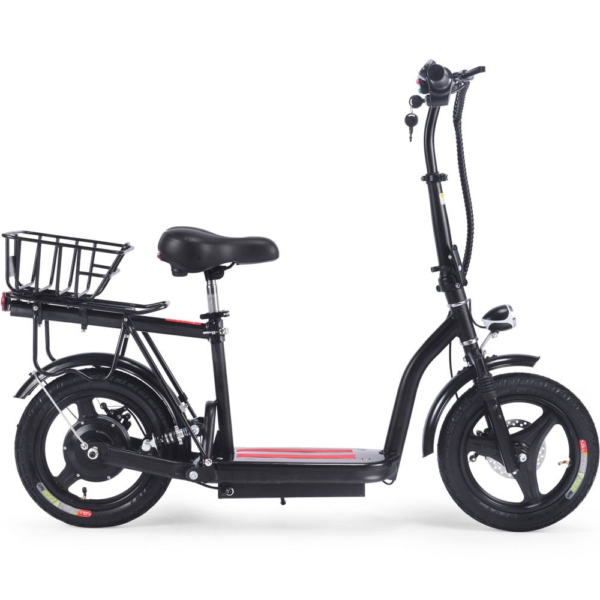
- Battery Range: 10–15 miles (16–24 km)
- Top Speed: 18 mph (29 km/h)
- Motor Power: 350 W
- Weight Capacity: 220 lb (100 kg)
- Charging Time: ~4–8 h
- Scooter Weight: Not specified
PROS
- 48V system with 350W hub
- Front & rear suspension
- 14″ pneumatic tires
- LED headlight and battery meter
- Rear luggage rack; key start
CONS
- 10–15 mile (16–24 km) range
- IP rating not specified
- Scooter weight not specified
- Top speed below 20 mph
Key Takeaways
- The MotoTec Cruiser is a compact, seated electric scooter ideal for short trips and daily rides.
- It features a 350-watt rear hub motor, 48-volt battery, and 14-inch air-filled tires for a smooth, stable ride.
- With simple controls and comfortable seating, it suits new riders and those running errands.
- Though not suitable for high-speed or long-distance commuting, the Cruiser excels on flat paths and campus settings.
- Basic maintenance and weather considerations ensure longevity, while security measures protect against theft.
Table of contents
- What Is the MotoTec Cruiser?
- How the MotoTec Cruiser Works
- Key Specifications
- Design & Build Quality
- Performance Fundamentals
- Battery, Range & Efficiency
- Ride Quality & Comfort
- Braking & Safety Features
- Portability & Daily Usability
- Maintenance & Care
- Weather & Seasonal Considerations
- MotoTec Cruiser vs Alternatives
- Who the MotoTec Cruiser Is (and Isn’t) For
- FAQs
- Glossary
The MotoTec Cruiser is a compact, seated electric scooter for short trips and easy daily rides. It runs a 48-volt system with a 350-watt rear hub motor and big 14-inch air-filled tires. If you want a sit-down scooter for campus, errands, or a mellow commute, the MotoTec Cruiser makes sense. And it keeps controls simple, so the learning curve stays short.
Who will like it most? Riders who want a seat, soft suspension, and a smooth, predictable throttle. You get calm speed, steady handling, and a cockpit that feels familiar right away.
What Is the MotoTec Cruiser?
The MotoTec Cruiser is a small, foldable, seated scooter with a steel frame and a rear luggage rack. It uses a brushless 350-watt rear hub motor and a 48 V 8 Ah lithium-ion battery. You get front and rear shocks, disc brakes on both wheels, and a twist throttle. There’s a key start, an LED headlight, and a simple battery meter. So the layout feels a lot like a light moped, only simpler.
The deck is short. The seat sits over the rear half of the frame. The cockpit uses bike-style bars with short-reach levers. Then the headlight mounts low near the front fender. The 14-inch pneumatic tires roll over cracks that would bother small wheels, and that helps the scooter track straight at modest speed. It’s not fancy, but it’s friendly.
How the MotoTec Cruiser Works
Think of the Cruiser as a tidy electric moped with a direct drive. Each part does a clear job, and together they keep the ride easy.
- Motor: A 350-watt brushless hub sits inside the rear wheel. It turns the wheel directly, so there’s no chain or belt. That keeps the ride quiet and care simple.
- Controller: A small controller feeds the motor and limits current to manage heat. It offers three speed modes that cap top speed. So you can pick the feel you want.
- Battery: A 48 V, 8 Ah lithium-ion pack stores the energy. A basic protection board guards charging and discharging. It’s straightforward and proven.
- Throttle: A half-twist throttle on the right grip sends a signal to the controller. Roll to go. Ease off to coast. Then the controller blends current in smoothly.
- Brakes: Mechanical disc brakes sit at the front and rear. Once pads bed in, lever feel turns firm and predictable. That makes slow maneuvers less tense.
Daily use is plain. Turn the key, pick a mode, twist to move, and squeeze to stop. Then park on the kickstand and lock it like a bike. That’s the routine.
Key Specifications
| Block | Details |
|---|---|
| General | Type: seated, foldable electric scooter with rear rack; Frame: steel; Tire type: 14-in pneumatic front and rear |
| Performance & Power | Motor: 350 W brushless rear hub; Speed modes: 6, 11, 16 mph (≈ 9.7, 17.7, 25.7 km/h); Max slope: 15°; Max rider weight: 220 lb (≈ 100 kg) |
| Battery, Charging & Electrical | Battery: 48 V 8 Ah lithium-ion (≈ 384 Wh); Charger: included; Charge time: 4–8 hours; Battery meter: yes; Headlight: LED |
| Build & Dimensions | Foldable: yes; Folded size: 51 × 25 × 25 in (≈ 129.5 × 63.5 × 63.5 cm); Product size: 53 × 26 × 38 in (≈ 134.6 × 66.0 × 96.5 cm); Box size: 45 × 12 × 21 in (≈ 114.3 × 30.5 × 53.3 cm); Product weight: not published; Box weight: 84 lb (≈ 38.1 kg) |
| Safety & Control | Brakes: front and rear mechanical disc; Lights: headlight; Reflectors: not listed; IP rating: not listed |
| Features & Extras | Front and rear suspension; Twist throttle; Key start; Battery meter; Rear luggage rack; Cruise Control: not listed |
| Warranty & Compliance | Warranty: 30-day parts replacement; Local riding rules vary by region; Charger/electrical compliance: not listed |
These are the official core facts, so you get the basics up front.
Design & Build Quality
The frame uses steel tubing with a folding joint in front of the deck. The deck supports a seated stance, and the seat post anchors near the rear triangle. So your feet rest close, which helps balance at low speed. The stem holds a wide handlebar with short-throw levers, a twist throttle, and a keyed switch. Then the headlight sits low, out of the way, yet still useful on dim paths.
Fit and finish match the job. Welds are plain but solid. Plastics around the fenders and headlight feel basic, yet they take normal bumps. The brake rotors are small, which trims rotating mass. So the wheels spin up fast, and the steering stays light at slow speed.
The folding latch has a short throw. It is not a one-hand, commuter latch. Even so, it keeps the stem steady at cruise. The long wheelbase and 14-inch tires give the scooter a planted stance. And the rear rack adds real utility. Toss on a small bag or strap a light crate, and errands get easier.
Performance Fundamentals
This scooter favors calm riding over sprints. Roll into the throttle, and the 350-watt hub pulls cleanly from a stop. The first few feet feel soft. That keeps control easy in tight spaces. Then it builds to a steady cruise in the top mode.
On flat ground, the highest mode caps near 16 mph (≈ 25.7 km/h). That pace fits bike paths, neighborhood streets, and campus roads with low limits. The big tires help here. They shrug off pebbles and gaps that can unsettle 8-inch wheels, and the Cruiser feels stable and predictable.
Hill work is modest. On 7–10% grades, expect speed to dip. The motor will climb if you carry some momentum. Heavier riders or long hills slow it more. So pick a good line, roll in with a bit of pace, and hold steady throttle. Then use a lower mode on the way down to keep speed in check and save pad wear.
Low-speed control stands out. You sit upright. The wide bar gives leverage. So U-turns on a path feel natural. Curb cuts are simple. The big tires step off small lips without much fuss. In crowded areas, that kind of easy control helps every ride.
Battery, Range & Efficiency
The 48 V 8 Ah pack stores about 384 Wh. In the top mode on flat routes, lighter riders land near the low end of the rated window. In a lower mode, many riders reach the high end. So plan on roughly 10–15 miles (≈ 16–24 km), with weight, stops, hills, wind, and temperature shaping the result.
Cold weather trims range. Headwinds do the same. Hot days ease discharge stress but can age cells faster over time. So store the scooter indoors, and keep the pack near half when it sits for weeks. Then top up before you ride.
Charging is simple. Plug in, wait for the light to turn green, and let the pack rest a few minutes. Try not to run the battery flat day after day. Keeping daily use between about 20% and 80% helps cycle life. So charge when it fits your schedule, not only when it’s empty.
If you want a quick gauge, track bars used on your normal loop. Do it for a week. Then pick a charge routine that keeps you clear of empty without sitting at 100% all day.
Ride Quality & Comfort
Comfort starts with tire volume. The 14-inch pneumatic tires run lower pressure than small scooter tires. So they soak up cracks and seams before the shocks even get busy. The front and rear shocks add a second layer of give. And the seated posture takes load off your knees.
At the bar, the stem stays calm at cruise. The long wheelbase and tall tires help. Minor shakes fade fast, and the scooter tracks straight with one hand. Rough patches still come through, sure, but the volume and suspension take the edge off.
Ergonomics feel easy. The twist throttle is simple to modulate with or without gloves. The levers sit within natural reach. And the seat height gives a neutral knee bend for most teens and adults. If your route is rough, check tire pressure weekly. Lower adds comfort, but too low risks pinch flats. So start mid-range and tweak a little at a time.
For long days, stand at stoplights for a minute to reset your back and hips. Then sit again and carry on. It helps more than you’d think.
Braking & Safety Features
The Cruiser uses cable-actuated disc brakes front and rear. Once pads bed in, lever travel shortens and bite firms up about halfway through the pull. So slow, precise stops in bike traffic feel easy. For emergency stops, pull both levers and shift weight back. The big tires add grip, and the frame stays straight.
Lighting is basic. You get a headlight that helps you be seen and adds some forward light at path speeds. A rear light is not listed, so add a clip-on taillight for night rides. Then throw on reflective ankle bands or use a reflective bag for side visibility. Little things help at dusk.
The scooter has no stated water-ingress rating. So avoid deep puddles and heavy rain. Skip pressure washers. Wipe it down with a damp cloth. Then dry the rotors and lever pivots to keep feel crisp.
Portability & Daily Usability
Folding cuts height and length, so storage gets easier under a desk or in a hallway. The folded size is 51 × 25 × 25 in (≈ 129.5 × 63.5 × 63.5 cm), which fits many trunks. Product weight isn’t listed, yet the boxed weight is 84 lb (≈ 38.1 kg). So carrying up long stairs feels awkward. Plan to roll when you can.
Daily habits stay simple. Turn the key, pick a mode, and ride. Lock the frame to a rack through the main triangle or use a heavy chain through the rear wheel and frame. Then bring the charger inside if you need a mid-day top-up. In shared storage rooms, a small cover keeps dust off.
Security matters. Use a quality U-lock on the frame in a visible spot. Then add a short cable through the front wheel. Take photos of the scooter and key, and record the serial number. If you later add a small tracker, hide it deep near the rack mounts or under the seat.
Maintenance & Care
Keep a short checklist. Stick to it. The scooter will thank you.
- Before each ride: Squeeze both brakes to confirm bite. Check the key switch and throttle. Scan tires for cuts or low pressure. Spin each wheel and listen for rub.
- Weekly: Check tire pressure. Wipe dirt from shock rods. Inspect pads for even wear. Then confirm the headlight bracket is tight.
- Monthly: Tighten stem bolts, axle nuts, and rack screws. Check rotor bolts. Clean and lube lever pivots and cable ends. Then check the seat clamp for play.
- Every 3–6 months: Inspect the battery connector and charge port. Check the headset and wheel bearings for play. Replace pads if the friction layer is thin. Then tap spokes and listen for even tone.
Set reminders so checks don’t slip. Small tasks beat big repairs. Five minutes of cable lube keeps lever feel smooth and protects liners.
Weather & Seasonal Considerations
Rain changes traction fast. The 14-inch tires help, yet painted lines and metal plates still get slick. So slow down, brake early, and keep the scooter upright through turns. After puddles, drag the brakes lightly to dry the rotors. Then wipe the hub area and shock rods when you get home.
Heat speeds lithium aging. So store the Cruiser in the shade on hot days and never in a closed car. Cold thickens grease and raises internal resistance. Then range drops and braking feel turns stiff. So warm the scooter indoors before charging in winter. Expect a smaller range window until spring.
Road salt adds corrosion risk. Rinse the underside with a gentle stream after salty days. Then dry bolts, rotor faces, and the kickstand area. For longer storage, park the battery near half and check it monthly. That habit keeps the pack healthier across seasons.
MotoTec Cruiser vs Alternatives
The Cruiser leans into comfort and simplicity rather than speed. Big tires, a seat, and dual shocks make path miles easy. And the three speed modes help new riders ease in.
Stand-up commuters sprint faster and fold quicker. Even so, they can feel harsh on cracked pavement, and long rides tire your legs. The Cruiser flips that trade. You sit, relax, and accept a calmer top speed. Then you finish longer rides without sore knees.
Performance scooters push hard on hills and reach higher speeds. They add weight, cost, and stronger brakes. If you need steep hill pace or 25–30 mph runs, that class fits. If you want a seated ride for short routes, the MotoTec Cruiser stays the better match.
Off-road models bring knobby tires and long-travel suspension. They shine on dirt and roots. But they feel big in city racks and tight hallways. If most of your miles are paved, the Cruiser’s compact frame and smooth tires fit better.
If you want a lighter stand-up option from the same brand, check the MotoTec Metro. If you need far more power and a stand-up deck, the MotoTec 2000W 48V Electric Scooter sits in a different class.
Who the MotoTec Cruiser Is (and Isn’t) For
Great for:
- Campus riders who want a seat and simple controls
- Short commutes on flat ground
- New riders who like calm modes and steady handling
- Neighborhood errands with a small bag on the rear rack
- Paths where a relaxed top speed feels right
Not ideal for:
- Riders who want 20–30 mph street pace
- Daily routes longer than 10–15 miles (≈ 16–24 km)
- Cities with frequent 10%+ hills
- Wet-weather use where an IP rating is required
- Buildings with lots of stairs and no ground-level storage
Take a few minutes and measure your route. Then check local rules. With that, the choice gets easy.
FAQs
How fast does the MotoTec Cruiser go?
In the highest mode it tops out near 16 mph (≈ 25.7 km/h). The other modes limit speed to about 11 mph and 6 mph. So you can set the cap to fit your route.
What is the real-world range?
Plan on 10–15 miles (≈ 16–24 km) per charge on flat ground. Heavier riders, hills, stops, wind, and cold cut that. Then a lower mode can stretch miles when needed.
Does it have regenerative braking?
No. Braking is mechanical disc front and rear. So lever feel stays consistent, and pad care matters.
Can I ride it in the rain?
There’s no stated water rating. So avoid heavy rain and deep puddles. Then dry the scooter after light spray.
Is there a tail light or brake light?
A headlight is listed. A rear light is not. So add a clip-on taillight for night rides and dusk commutes.
What tire pressure should I run?
Follow the sidewall range and start in the middle. Then tweak a few psi for comfort and pinch-flat protection. Check weekly to keep feel consistent.
Where can I read a quick MotoTec Cruiser overview?
You’re reading a MotoTec Cruiser overview right here. It packs the core facts, care tips, and ride traits in one place.
Glossary
- Ah (amp-hour): Battery capacity. Higher Ah means more stored charge.
- Wh (watt-hour): Voltage times amp-hours. It estimates stored energy.
- Controller: The box that meters power from the battery to the motor.
- Brushless hub motor: A motor built into the wheel that uses electronic switching.
- Speed mode: A controller limit that caps top speed.
- Regen: Regenerative braking that uses the motor to slow and recharge.
- Mechanical disc brake: A cable-actuated caliper that clamps a rotor.
- Pneumatic tire: An air-filled tire that cushions bumps and adds grip.
- Stem flex: Small bending of the steering column under load.
- Wheelbase: Distance between wheel centers. Longer usually means more stability.
- Grade: Hill steepness measured in percent.
- IP rating: Code for dust and water resistance.
- BMS: Battery management system that guards the pack.
- Bed-in: The process that mates new brake pads to the rotor.
- Torque: Turning force at the wheel.
Specifications
General
| Model The Model specifies the exact version or name of the scooter. It helps identify its unique design, features, and specifications within the manufacturer’s product line. Knowing the model makes it easier to compare options, find compatible accessories, or look up support information. | Cruiser |
| Brand The Brand identifies the manufacturer or company that designs and produces the scooter. A trusted brand is a sign of quality, reliability, and good customer support. Well-known brands often have higher standards for safety, performance, and after-sales service, giving you more confidence in your purchase. | MotoTec |
| Release Date The Release Date indicates when the scooter model was officially launched on the market. This helps you know how current the design, technology, and features are. A newer release date often means updated components, improved performance, and the latest safety or smart features. | 18 November 2025 |
| Recommended Age Recommended Age indicates the minimum age range that the scooter is designed for, based on safety, size, and ease of use. Following the recommended age helps ensure that riders can handle the scooter’s speed, weight, and controls comfortably and safely. Always check local laws and use protective gear, especially for younger riders. | +16 |
Performance & Power
| Motor Power (Wattage) What it means: The motor power, measured in watts (W), shows how strong the scooter’s electric motor is. Why it matters: Higher wattage usually means better acceleration, more torque, and improved performance on hills or rough terrain. For example, a 250W motor is good for flat city roads and light riders, while a 500W or 1000W motor provides more power for faster speeds or climbing steep inclines. | 350 W rear hub (brushless) |
| Top Speed The Top Speed indicates the maximum speed that the scooter can reach under optimal conditions. It’s usually measured on level ground with a fully charged battery and an average rider weight. A higher top speed allows you to travel longer distances faster, but always ensure you ride within legal speed limits and your personal comfort zone for safety. | 18 mph (29 km/h) |
| Battery Capacity Battery Capacity refers to the total amount of energy the scooter’s battery can store, usually measured in ampere-hours (Ah) or watt-hours (Wh). A higher battery capacity means you can ride longer distances on a single charge, reducing the need for frequent recharging. Keep in mind that actual range can vary depending on rider weight, terrain, speed, and weather conditions. | 48 V 8 Ah (384 Wh) |
| Estimated Range per Charge The Estimated Range per Charge indicates the average distance the scooter can travel on a single full battery charge. This range is calculated under optimal conditions, such as flat terrain, moderate speed, and average rider weight. Real-world range may vary depending on riding style, terrain, weather, and load. A longer range means fewer recharges and greater freedom for longer trips. | 10–15 miles (16–24 km) |
| Hill Climb Ability Hill Climb Ability describes the maximum incline or slope that the scooter can handle while maintaining stable performance. It’s typically expressed as a percentage or in degrees. A higher hill climb rating means the scooter can tackle steeper hills without losing too much speed or power. Actual climbing performance may vary based on rider weight, battery charge, and terrain conditions. | Up to 15° |
| Drive System The Drive System refers to how power from the motor is delivered to the wheels. Electric scooters typically use either a hub motor (directly integrated into the wheel) or a chain/belt drive system. A high-quality drive system ensures smooth acceleration, efficient power transfer, and low maintenance. The choice of drive system affects performance, noise level, and overall ride experience. | Rear hub (RWD) |
Charging & Electrical
| Charging Time Charging Time indicates how long it takes to fully recharge the scooter’s battery from empty to 100% using the standard charger provided. Faster charging means less downtime and more time on the road. Actual charging time may vary slightly depending on battery capacity, charger output, and environmental conditions. | Approx. 4–8 hours |
| Battery Type Battery Type refers to the specific technology used in the scooter’s battery, which affects performance, lifespan, weight, and charging time. Most modern electric scooters use high-quality lithium-ion (Li-ion) batteries because they offer a good balance of energy density, durability, and low maintenance. A reliable battery type ensures consistent power delivery and longer riding ranges. | Lithium-ion pack |
| Removable Battery A Removable Battery means the battery pack can be easily detached from the scooter for convenient charging and replacement. This feature allows you to charge the battery separately, swap it with a spare for extended range, or securely store it indoors in extreme weather. Removable batteries add flexibility and make it easier to keep your scooter powered up wherever you are. | Non-removable internal battery (fixed pack) |
| Regenerative Braking Regenerative Braking is an energy-saving feature that converts some of the energy normally lost during braking back into battery power. When you slow down or brake, the motor works in reverse to generate electricity, which helps extend the scooter’s range and improves overall efficiency. This system also reduces wear on traditional brake components, leading to lower maintenance over time. | No |
| Lighting Lighting refers to the built-in front and rear lights that enhance visibility and safety when riding in low-light conditions or at night. Good lighting helps you see the road ahead and ensures that other road users can see you. Many scooters include LED headlights, taillights, and sometimes brake lights or side reflectors for added safety and compliance with local traffic regulations. | LED headlight; battery meter |
Build & Dimensions
| Scooter Weight Scooter Weight refers to the total weight of the scooter when fully assembled, including the battery. This affects how easy it is to carry, lift, and store the scooter when not in use. A lighter scooter is more portable and convenient for commuting, especially if you need to carry it upstairs or onto public transport. Keep in mind that a sturdy frame and quality components may add to the weight but also contribute to better durability and ride stability. | Not specified |
| Maximum Rider Weight Maximum Rider Weight indicates the highest rider weight that the scooter is designed to safely support while maintaining optimal performance and stability. Staying within this limit helps ensure reliable acceleration, braking, and climbing ability, and it protects the frame, suspension, and motor from excessive strain. Exceeding the recommended limit may reduce performance and increase wear on components. | 220 lb (100 kg) |
| Deck Size Deck Size refers to the dimensions of the scooter’s standing platform. A wider and longer deck provides more foot space, allowing you to stand comfortably and adjust your stance while riding. A well-sized deck improves balance and stability, especially on longer rides or at higher speeds. Compact decks, on the other hand, help keep the scooter lightweight and portable. | Commuter frame with front & rear suspension |
| Handlebar Height Handlebar Height refers to the distance from the deck to the handlebars, which affects your riding posture and comfort. An appropriate handlebar height helps you maintain good balance, reduces strain on your back and arms, and makes steering more comfortable. Some scooters have adjustable handlebars to fit riders of different heights, while others have a fixed height for a streamlined design. | Fixed |
| Folding Mechanism The Folding Mechanism describes how easily and securely the scooter can be folded for carrying and storage. A well-designed folding system lets you quickly collapse the scooter into a compact size, making it convenient to transport on public transit, store under a desk, or fit into a car trunk. Look for sturdy latches and safety locks to ensure the scooter stays firmly in place when folded or unfolded. | Folding: Yes |
| Dimensions Folded Dimensions indicate the size of the scooter when it’s fully folded. This measurement shows how much space the scooter will take up when stored or carried, making it easier to check if it will fit in your car trunk, under a desk, or in a closet. Compact folded dimensions are ideal for commuters who need to bring their scooter on public transport or store it in tight spaces. | Unfolded: 53×26×38 in (134.6×66.0×96.5 cm); Folded: Not specified |
| Material Material refers to the primary construction materials used for the scooter’s frame and key components. High-quality materials like aircraft-grade aluminum, reinforced steel, or durable composites provide strength, stability, and a lighter overall weight. A sturdy material ensures the scooter can handle daily wear and tear while maintaining safety and performance. | Not specified |
Safety & Control
| Brake Type(s) Brake Type(s) describe the braking systems the scooter uses to help you slow down or stop safely. Common brake types include mechanical brakes (like drum or disc brakes), electronic brakes, and foot brakes. Many scooters combine multiple braking systems for added safety and shorter stopping distances. The type and quality of brakes affect your control, especially when riding at higher speeds or on slopes. | Front & rear disc |
| Suspension Suspension refers to the system that absorbs shocks and vibrations while riding, providing a smoother and more comfortable ride over uneven or rough surfaces. Scooters may have front suspension, rear suspension, or dual suspension for better shock absorption and stability. Good suspension helps reduce rider fatigue and improves control, especially when riding on bumpy roads or off-road paths. | Front & rear suspension |
| Tire Type Tire Type refers to the kind of tires the scooter uses, which directly affects ride comfort, traction, and maintenance. Common types include solid (airless) tires, pneumatic (air-filled) tires, or hybrid options. Pneumatic tires offer better shock absorption and a smoother ride on rough surfaces, while solid tires are puncture-proof and require less upkeep. The right tire type helps ensure safe handling and a comfortable ride in different conditions. | 14″ pneumatic street tires |
| Tire Size Tire Size indicates the diameter and width of the scooter’s tires, which affect ride comfort, stability, and how well the scooter handles different terrains. Larger tires generally offer better shock absorption and a smoother ride over bumps and rough surfaces, while smaller tires keep the scooter lighter and more portable. Choosing the right tire size helps ensure a balance between agility and comfort. | 14-inch |
| Kickstand The Kickstand is a built-in stand that allows you to park your scooter upright when it’s not in use. A sturdy kickstand keeps the scooter stable and prevents it from tipping over, protecting it from scratches and damage. It also makes storing and accessing your scooter more convenient, whether you’re at home, work, or on the go. | Not specified |
| Water Resistance Rating Water Resistance Rating indicates how well the scooter is protected against water and moisture, usually shown as an IP (Ingress Protection) rating. This rating helps you understand whether the scooter can handle light rain, splashes, or wet roads without damage. While most scooters are not fully waterproof, a good water resistance rating adds peace of mind when riding in changing weather conditions. Always avoid deep puddles or submerging the scooter to protect its electrical components. | Not specified |
Features & Extras
| Display/Console The Display (or Console) shows important real-time information about your ride, helping you monitor your scooter’s status at a glance. Typical displays show speed, battery level, distance traveled, and riding mode. Some models also include additional features like Bluetooth connectivity, app integration, or backlighting for better visibility at night. A clear and easy-to-read display enhances safety and convenience on every trip. | Battery meter; headlight indicator |
| Ride Modes Ride Modes refer to the different speed and power settings you can choose to match your riding style or road conditions. Common modes include eco for maximum range and energy efficiency, standard for everyday balance, and sport or turbo for higher speed and stronger acceleration. Switching between ride modes allows you to customize performance, conserve battery, and ride safely in various environments. | 3 speeds (approx. 6/11/18 mph) |
| Smart App Connectivity Smart App Connectivity lets you pair your scooter with a dedicated mobile app via Bluetooth. Using the app, you can monitor real-time ride stats like speed, battery level, and range, adjust settings such as ride modes or cruise control, lock the scooter for added security, and sometimes receive firmware updates. This feature adds convenience and allows you to personalize your riding experience right from your smartphone. | No app |
| Anti-Theft System The Anti-Theft System helps protect your scooter from unauthorized use or theft. This feature can include built-in alarms, electronic motor locks, GPS tracking, or remote locking through a mobile app. A good anti-theft system provides peace of mind when parking your scooter in public spaces, adding an extra layer of security to safeguard your investment. | Keyed ignition |
| Cruise Control Cruise Control allows you to maintain a steady speed without continuously holding the throttle. This feature makes longer rides more comfortable by reducing hand fatigue and providing a smoother, more relaxed riding experience — especially on flat, open roads or bike lanes. For safety, cruise control can usually be easily activated or deactivated while riding. | Not specified |
| Accessories Included Accessories Included lists the additional items that come with the scooter to enhance your riding experience and convenience. Common accessories may include a charger, kickstand, bell, lights, phone holder, or carrying strap. These extras add value by making your scooter safer, easier to use, and ready to ride straight out of the box. | Scooter, charger, tools, manual |
Warranty & Compliance
| Warranty Period The Warranty Period indicates how long the manufacturer guarantees the scooter against defects in materials and workmanship under normal use. A good warranty provides peace of mind, showing the brand’s confidence in its product quality. Always check what parts are covered, such as the frame, battery, and motor, and follow the maintenance guidelines to keep your warranty valid. | 30 days parts replacement (region-dependent) |
| Certifications Certifications confirm that the scooter meets specific safety, quality, and environmental standards set by recognized organizations or regulatory bodies. Common certifications may include CE, RoHS, UL, or other local compliance marks, depending on your region. These certifications ensure that the scooter is manufactured to high standards and is safe and legal to use in your country. | Local micromobility compliance |


